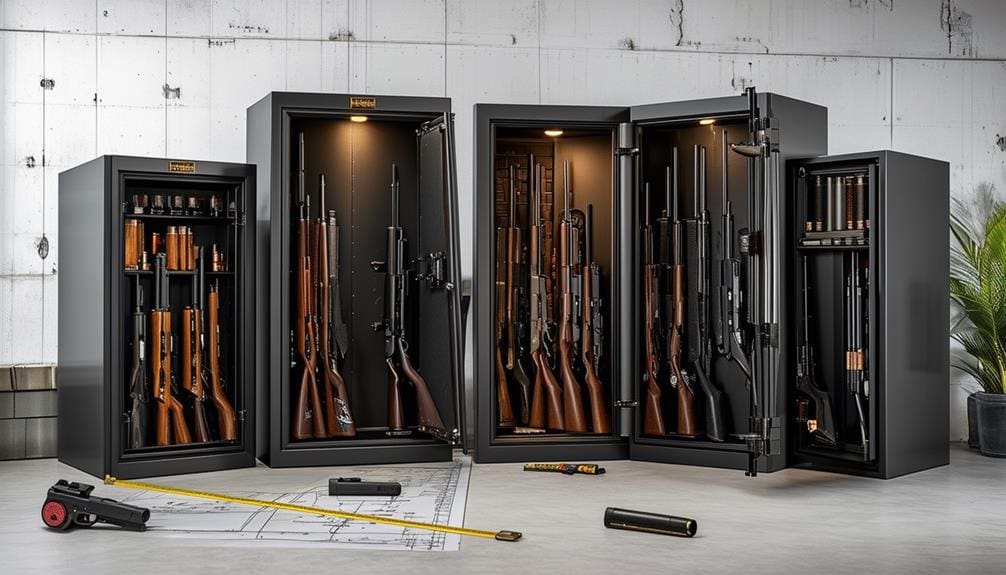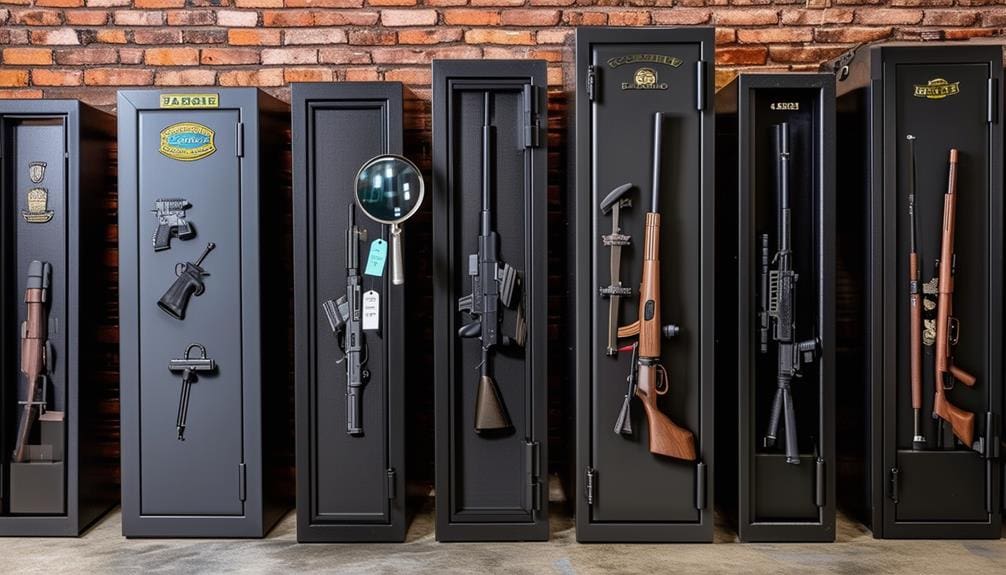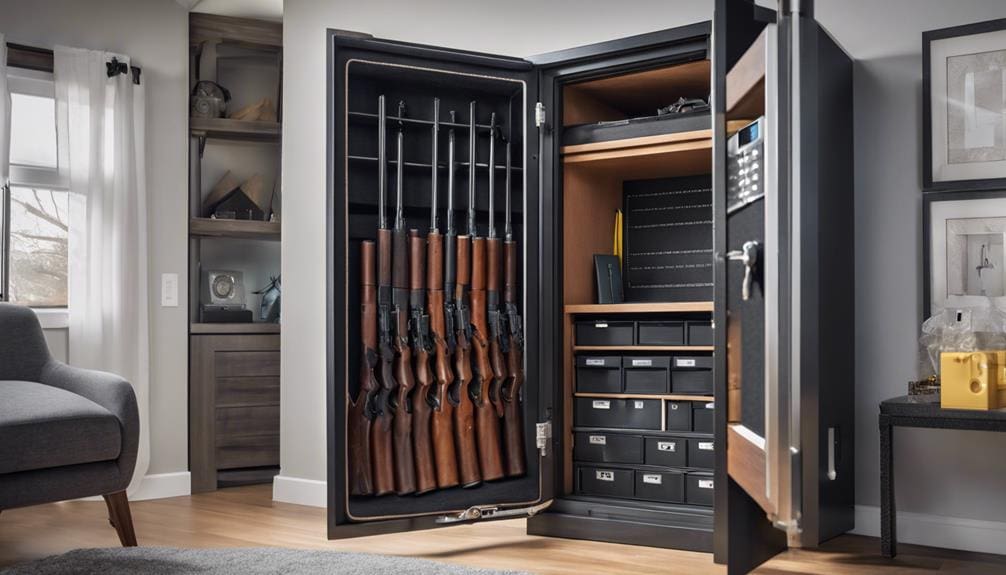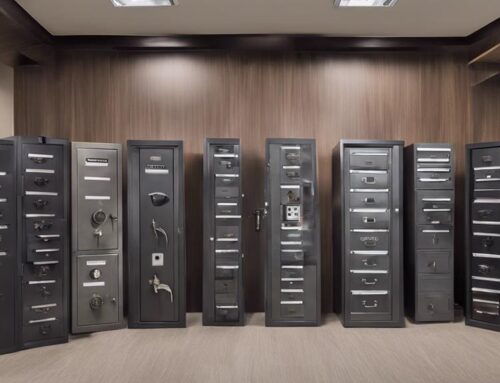When selecting a gun safe, prioritize security features such as sturdy steel construction and UL burglar ratings (RSC, TL-15). Choose dependable locking mechanisms and consider duplicate systems for added security. Pick a safe that accommodates your current firearms and allows for future additions. Confirm certification for both theft and fire protection, and search for high fire ratings. Establish your budget early, weighing essential security features against cost. Always keep an eye out for sales and financing alternatives to make your purchase more economical. By taking these factors into account, you’ll be well on your path to making an informed purchase decision.
Key Takeaways
- Evaluate Security Features: Prioritize safes with UL burglar ratings, solid steel construction, and reliable locking mechanisms like electronic, combination, or biometric locks.
- Consider Size and Capacity: Choose a safe that fits your current collection, allows for future expansion, and has shelves for efficient organization.
- Check Certification and Ratings: Ensure the safe has proper UL security and fire ratings, and fire seals for enhanced protection.
- Balance Budget and Security: Determine your budget, prioritize essential security features, and look for sales or financing options to maximize value.
- Measure Available Space: Ensure the safe fits comfortably in your home, considering both the size of the safe and the space where it will be placed.
Security Features
When choosing a gun safe, prioritize those with UL burglar ratings like RSC, B-Rated, or U.L. TL-15 to guarantee robust security against break-ins. These ratings guarantee your safe can withstand significant tampering attempts, giving you peace of mind.
Focus on reliable locking mechanisms. Electronic, combination, and biometric locks all provide varied levels of security. Each type offers specific advantages, but all aim to prevent unauthorized access. An enhanced security measure is to choose safes with solid steel construction. A thick steel door resists drilling, prying, and cutting, adding an essential layer of protection.
Consider safes equipped with redundant locking systems. These systems enhance security by requiring multiple steps or keys to open, greatly reducing the chances of a successful breach. Additional security features like alarm systems and monitoring capabilities offer extra layers of defense. Alarms can alert you to any unauthorized access attempts, while monitoring systems can provide real-time updates on your safe’s status.
Lastly, ensure the safe’s tamper-resistant design. This involves features specifically crafted to resist manipulation and forced entry, further securing your firearms. By meticulously evaluating these security features, you can confirm your gun safe provides maximum protection.
Size and Capacity

After ensuring your gun safe has robust security features, turn your attention to selecting the appropriate size and capacity to meet your specific needs. Start by considering the number and size of firearms you currently own. The gun safe size should comfortably house your collection without overcrowding, which can lead to damage.
Next, think about potential future purchases. You don’t want to outgrow your safe too quickly, so choose a capacity that allows for expansion. Beyond firearms, evaluate if you need space for other valuables or important documents. This will help you determine the additional storage space required.
Look for gun safes equipped with shelves and compartments. These features help organize and maximize storage space efficiently, preventing mess and making your items easily accessible.
Lastly, measure the available space where you plan to install the safe. Ensuring a proper fit is essential for both functionality and security. The safe should not only fit your firearms and valuables but also the physical space in your home.
Certification and Ratings
Understanding certification and ratings is crucial for selecting a gun safe that meets your security needs. You need to take into account various certifications to make sure that your safe provides the necessary protection against theft and fire.
- UL RSC: This rating confirms that the safe can withstand specific attacks for a set amount of time, typically five minutes, and is suitable for residential use.
- UL TL-15 and UL TL-30: For higher security levels, look for safes with these ratings. They indicate that the safe can endure sophisticated attacks by experienced burglars using tools for 15 and 30 minutes, respectively.
- Fire ratings: Independent testing agencies provide fire ratings such as 1-hour or 2-hour protection. These ratings guarantee that your valuables remain safeguarded during a fire.
- Fire seals: Opt for safes with fire seals, which protect contents from heat and smoke, thereby enhancing the overall fire protection capabilities.
- Biometric locks: These advanced security features offer convenient access and make sure that only authorized individuals can open the safe.
Budget Considerations

While certifications and ratings guarantee the quality and security of a gun safe, it’s equally vital to assess how these features align with your budget. First, determine your budget range, as prices can vary significantly, from a few hundred dollars to several thousand. Consider the cost versus security by evaluating the level of security features, such as fireproofing and locking mechanisms, you require.
Look for sales and discounts to stretch your budget further. Many retailers offer promotions or financing options, making it easier to afford a quality gun safe without compromising essential features. Financing can spread the cost over time, aligning it more comfortably with your financial situation.
Investing in a quality gun safe is essential for the long-term security and protection of your firearms and valuables. Balance your budget by prioritizing essential features like robust security ratings, effective fireproofing, and reliable locking mechanisms. Determine what features are non-negotiable and where you could potentially compromise without sacrificing safety.
Frequently Asked Questions
What Are the Considerations for a Gun Safe?
When choosing a gun safe, consider the size options and interior layout for your firearms. Evaluate locking mechanisms like biometric access, and security features. Check the price range, brand reputation, warranty coverage, portability factor, and waterproofing options.
How to Choose a Safe for Home?
When selecting a home safe, evaluate security features, size options, locking mechanisms, portability factor, interior layout, waterproof capabilities, biometric access, price range, installation process, and warranty coverage. These considerations guarantee excellent protection and functionality.
What Is the Best Material for a Gun Safe?
For the best gun safe material, choose steel. Steel vs. aluminum shows steel’s superior security. Titanium options are costly. Avoid plastic versus metal debates. Wood or metal? Always metal. Carbon fiber benefits and fiberglass pros and cons don’t compare.
How Much Fire Rating Do I Need in a Safe?
You need a fireproof rating of at least 1 hour. Consider safe capacity, lock type, brand reputation, price range, size options, installation process, durability factor, interior layout, and security features to ensure thorough protection for your valuables.
Conclusion
Choosing a gun safe is like selecting a guardian for your treasures. Guarantee it has robust security features, much like a knight’s armor. Size and capacity should fit your collection, akin to finding the right-sized chest. Certification and ratings are your map, guiding you to the best options. Finally, your budget is the compass, keeping you on course. Follow these steps, and you’ll find the perfect guardian for your prized possessions.



